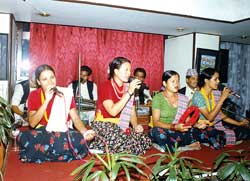 A new genre of music is sweeping Nepal. From Hits, Image and Kantipur FM to Radio Nepal's AM bands, Lok Dohari folk duets rule the airwaves. The music video market is dominated by Nepali pop. In the markets of tarai, Maithili, Bhojpuri, and Awadhi songs with double entendre set to techno music have begun to replace Hindi hits at local bajars. These are happening times for Nepali music.
A new genre of music is sweeping Nepal. From Hits, Image and Kantipur FM to Radio Nepal's AM bands, Lok Dohari folk duets rule the airwaves. The music video market is dominated by Nepali pop. In the markets of tarai, Maithili, Bhojpuri, and Awadhi songs with double entendre set to techno music have begun to replace Hindi hits at local bajars. These are happening times for Nepali music.
And, as a reflection of the times, a new Nepali Soul is emerging. Soul was the musical outpouring of American blacks forced to cities of the North and represented the distress of displacement. It sings of suffering, separation, loss of hope, bereavement, and melancholy with occasional self-mockery. People uprooted from their homes for reasons beyond their control find comfort in songs of love and longing.
Unprecedented numbers of Nepalis have been displaced from their places of birth in the last decade, it is the biggest involuntary migration in Nepali history. And they have taken to Nepali Soul to find their moorings.
The overseas Nepali audience croons with the sound of rhythm and blues and goes ecstatic with 1974 AD's Je gar je bhana jatasukai laijau malai, Yo man ta mero Nepali ho. The logic of the success of this song is simple: play it on your car sound-system with a Nepali flag sticker while you drive on endless expressways of an alien land to assert your belongingness to a faraway home.
The Nepali Diaspora is lapping up music from home like never before. It's not just established names like Nepathya and 1974AD performing in front of homesick comptariots, even greenhorn musicians talk about the overseas market as a separate category altogether. Nepali singers regularly go on diaspora tours. Babin Pradhan, Yam Baral, Nhyu Bajracharya and Raju Tuladhar entertained a Nepali crowd of around 500 in Woolwich Public Hall in East London recently after a successful US tour. Imagine a Nepali guard in Iraq listening to Ram Krishna Dhakal sing Bihana utthne bittikai himal dekhna paiyos. Last week, Deepak Bajracharya became the first Nepali singer to be net-cast directly from his studio in Kathmandu.
More are sure to follow in his footsteps. Meanwhile, the local audience in Nepal is swooning to an emotive mixture of rock, jazz, disco, and folk-the fusion of it all that makes the Nepali Soul.
Lok Dohari singers like Bima Kumari Dura and Sindhu Malla are our new superstars, and some newspapers even have separate chartbusters of Lok Dohari and Nepali pop. The music and lyrics are simple: madal, flute, guitar and the raw energy of the singers' voices.
Nepali modern songs have become anthems for the newly literate displaced from their ancestral homes. It's difficult not to be moved with Ekadashi Bajaraima or Wari Jamuna, pari Jamuna of Khem Raj Gurung. You may have never seen Ilam Bajar, but Badalu ko ghumto ma will make you long for the place. These songs celebrate the Proustian remembrance of things past.
Till a few years ago, very few listeners bought Maithili cassettes. Now Rupa Jha and Rama Mandal have become such familiar names in Janakapur and Rajbiraj, and few remember Udit Narayan Jha's early Maithili renditions for Radio Nepal. Rupa Jha's Chaita baisakha ke purain dah sings of gender bias rampant in Mithila and doesn't fail to bring tears even to grownup eyes.
This year, play-time for deusi and bhailo have been severely curtailed by the administration, but keep your ears tuned for the fresh rendering Rato mato, chiplo bato sung to the tune of Buffalo Soldiers.



